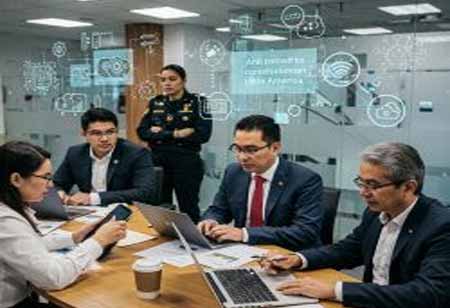THANK YOU FOR SUBSCRIBING
Be first to read the latest tech news, Industry Leader's Insights, and CIO interviews of medium and large enterprises exclusively from Gov CIO Outlook
THANK YOU FOR SUBSCRIBING

By
Government CIO Outlook | Tuesday, May 28, 2024
Stay ahead of the industry with exclusive feature stories on the top companies, expert insights and the latest news delivered straight to your inbox. Subscribe today.
Technology enhances disaster preparedness through early warning systems, communication tools, and data analysis while robust security safeguards critical infrastructure and minimises vulnerabilities.
FREMONT, CA: Integrating technology and security measures bolsters disaster preparedness efforts in this rapidly technologically advanced world. The symbiotic relationship between technology and security plays a pivotal role in enhancing the ability to mitigate, respond to, and recover from diverse crises. From early warning systems to sophisticated surveillance networks, innovative technological solutions provide vital tools for forecasting, monitoring, and managing disaster events.
Advanced Evaluation of Risk: Modern technology makes sophisticated risk assessment models that use geographical information systems (GIS), historical data, and predictive analytics possible. These tools analyse historical events to find patterns and trends that help authorities prepare for future disasters and deploy resources appropriately.
Early Alerting Mechanisms: A timely warning of looming disasters can save lives. Technology-driven early warning systems give communities and individuals real-time alerts so they can take the appropriate safety measures or evacuate. These technologies, which range from weather prediction models to apps that alert users to impending earthquakes, enable people to make wise decisions when it matters most.
Technologies of Communication: Communication is critical to emergency response. Technologies like social media platforms, smartphone apps, and satellite connections make real-time communication between authorities, responders, and the impacted populace possible. In particular, social media is a great tool for spreading knowledge, planning relief operations, and connecting those in need with resources.
Remote sensing and drones: Drones fitted with cameras and sensors have transformed disaster response operations. They deliver overhead photos of the impacted areas, evaluate the damage, and support the organisation of rescue efforts. Responders may also use remote sensing technologies to track the spread of illnesses, monitor environmental changes, and evaluate the impact of disasters on infrastructure.
Wearable Technology for Emergency Services Personnel: Wearable technology improves first responders' safety and situational awareness. In addition to protecting first responders in the field, smart helmets, body cams, and health monitoring equipment supply essential data for continuing evaluations and advancements in disaster response tactics.
Critical Infrastructure Cybersecurity: Critical infrastructure, including water supply, communication networks, and electricity grids, is significant to modern society. Cybersecurity measures are crucial to protect these systems from online threats and attacks. Governments and companies can prevent disruptions that could make a disaster worse by implementing strong cybersecurity measures.
Keeping Emergency Management Systems Safe: Malicious actors may target emergency management systems themselves. It is crucial to secure emergency management systems to prevent illegal access, data breaches, and manipulation of important data. A thorough security strategy must include multi-factor authentication, encryption, and frequent security assessments.
Programs for Community Training: Training programs that mimic disaster scenarios can significantly increase people's and communities' readiness. These courses cover emergency communication equipment use, evacuation protocols, and first aid. The proficiency acquired from instruction amplifies the efficacy of reactions in actual circumstances.
Campaigns for Public Awareness: An ongoing endeavour is to increase public understanding of the significance of catastrophe preparedness. Campaigns for public awareness educate the public about possible hazards, available resources, and how technology contributes to disaster resilience through various communication methods. Communities with greater knowledge are more inclined to handle crises with grace.
By embracing this symbiosis, communities are better equipped to confront and overcome the challenges posed by disasters, safeguarding lives, livelihoods, and the fabric of society itself. Thus, the ongoing advancement and integration of technology and security are enduring pillars in the collective pursuit of disaster preparedness and resilience.
More in News
I agree We use cookies on this website to enhance your user experience. By clicking any link on this page you are giving your consent for us to set cookies. More info



